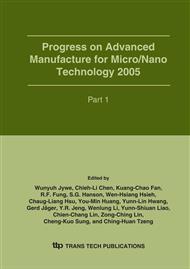p.643
p.649
p.655
p.661
p.667
p.673
p.679
p.685
p.691
Quantum Dots CdSe/ZnS-Loaded Poly(D,L-Lactide-Co-Glycolide) Nanoparticles: Physicochemical Characterization and Application
Abstract:
This paper described and characterized the quantum dots (QDs) with/without the polymeric PLGA applied in MC3T3E-1 delivery. Neat QDs were treated with various solvents, temperatures, exposure time and concentration to evaluate their stability and efficacy. We found that the intensity degree of fluorescence spectra (QDs) in different solvents follows the order: ether > THF > acetone > chloroform > methanol. Importantly, the QDs become inactive after 8-hr dissolution in the solvents of ether, THF or chloroform. According to this result, acetone and methanol are ideal solvents for QDs. The optimum concentration range of QDs in acetone is 5 to 10 mg/mL. We found that no obvious difference of fluorescence intensity was detected in QDs stored respectively at 4 °C, 24 °C and 44 °C (8-hour). When QDs were exposed to UV light (312 nm) for 2 hr, serious decay of fluorescence intensity was observed. In order to extend the application of QDs in medical areas, we encapsulated them in individual biocompatible poly(d,l-lactide-co-glycolide) (PLGA) nanoparticles for in-vitro imaging of endocytosis in MC3T3E-1 cells. We demonstrated that the polymeric PLGA have the ability to permeate the cells for cellular internalization; the endocytotic activity could be enhanced by the polymeric QDs-encapsulated PLGA.
Info:
Periodical:
Pages:
667-672
Citation:
Online since:
January 2006
Authors:
Price:
Сopyright:
© 2006 Trans Tech Publications Ltd. All Rights Reserved
Share:
Citation:


